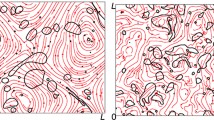Abstract
A kinetic approach based on the approximate calculation of the fluid flow potential and formulation of Hamilton’s equations for generalized coordinates and momenta of bubbles is employed to describe processes of collective interaction of gas bubbles moving in an inviscid incompressible fluid. Kinetic equations governing the evolution of the distribution function of bubbles are derived. These equations are similar to Vlasov equations.
Similar content being viewed by others
References
A. Biesheuvel and L. Wijngaarden, “Two-phase flow equations for a dilute dispersion of gas bubbles in liquid,”J. Fluid Mech.,148, 301–318 (1984).
J. B. Kok, “The Fokker-Planck equation for bubbly flows and the motion of gas bubble pairs,”Appl. Sci. Res.,58, Nos. 1-4, 319–335 (1997–1998).
A. Biesheuvel and W. C. M. Gorissen, “Void fraction disturbance in a uniform bubbly liquid,”J. Multiphase Flow,16, 211–231 (1990).
G. Russo and P. Smereka, “Kinetic theory for bubbly flow I: Collisionless case,”SIAM J. Appl. Math.,56, No. 2, 327–357 (1996).
R. I. Nigmatulin,Dynamics of Multiphase Media, Parts 1 and 2, Hemisphere Publ., New York (1991).
V. E. Nakoryakov, V. G. Pokusaev, and I. R. Shreiber,Wave Propagation in Gas- and Vapor-Liquid Media [in Russian], Institute of Thermal Physics, Novosibirsk (1983).
M. A. Lavrent’ev and B. V. Shabat,Problems of Hydrodynamics and Their Mathematical Models [in Russian], Nauka, Moscow (1973).
I. I. Gradshteyn and I. M. Ryzhik,Tables of Integrals, Series, and Products, Academic Press, New York, (1980).
O. V. Voinov and A. M. Golovin, “Lagrange equations for a system of bubbles with variable radii in a small-viscosity fluid,”Izv. Akad. Nauk SSSR, Mekh. Zhidk. Gaza, No. 3, 117–123 (1970).
R. M. Garipov, “Closed equations of motion for a fluid with bubbles,”Prikl. Mekh. Tekh. Fiz., No. 6, 3–24 (1973).
O. V. Voinov, “Motion of a sphere with variable radius near a flat surface in an inviscid fluid,”Izv. Akad. Nauk SSSR, Mekh. Zhidk. Gaza, No. 5, 94–103 (1971).
R. Liboff,Introduction to the Theory of Kinetic Equations, Wiley, New York (1969).
L. V. Ovsyannikov,Introduction to the Mechanics of Continuous Media [in Russian], Vol. 1, Izd. Novosibirsk. Univ., Novosibirsk (1976).
Additional information
Lavrent’ev Institute of Hydrodynamics, Siberian Division, Russian Academy of Sciences, Novosibirsk 630090. Translated from Prikladnaya Mekhanika i Tekhnicheskaya Fizika, Vol. 41, No. 5, pp. 130–138, September–October, 2000.
Rights and permissions
About this article
Cite this article
Teshukov, V.M. Kinetic model of bubbly flow. J Appl Mech Tech Phys 41, 879–886 (2000). https://doi.org/10.1007/BF02468734
Received:
Issue Date:
DOI: https://doi.org/10.1007/BF02468734




